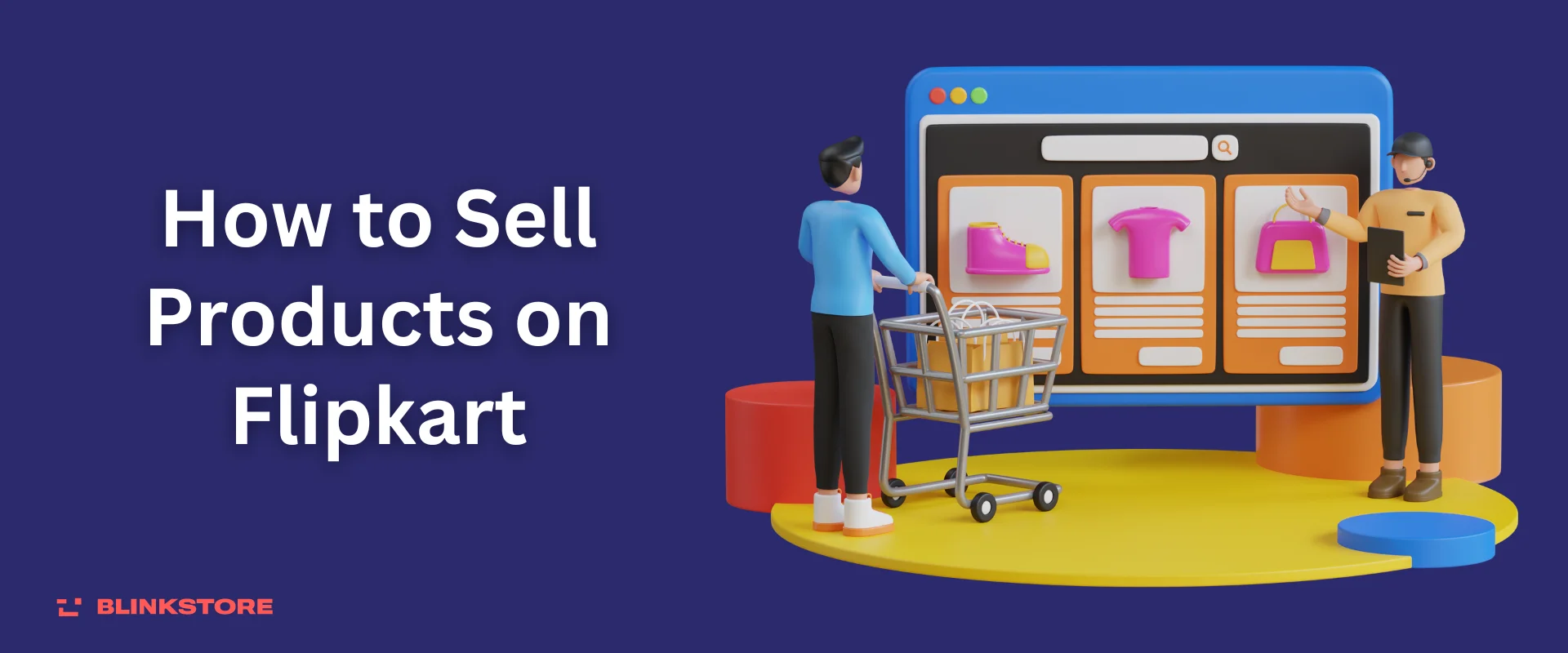In today’s digital age, selling things online has become a popular and effective strategy for businesses to extend their customer base and improve sales. Flipkart, one of India’s leading e-commerce platforms, allows retailers to reach millions of buyers nationwide.
Whether you’re a small company owner or a huge shop, selling on Flipkart can be a terrific method to increase sales and develop your brand. We’ll walk you through the entire process from registering as a seller to maintaining your inventory and fulfilling orders. Excited already? Let’s see how to sell products on Flipkart easily and book profits!
Table of Contents
Introduction
Flipkart is one of India’s biggest e-commerce platforms and has experienced enormous growth over the years. It was formed in 2007 and began as an internet bookstore. But, it has since grown to provide a diverse range of things such as electronics, household appliances, apparel, and more.
Flipkart currently has over 300 million registered users and over 150 million products on its site. Flipkart has also allowed many small and large businesses to go online and book profits. But before we look at how to sell products on Flipkart, let’s take a look at the reasons to sell on Flipkart.
Why sell on Flipkart?
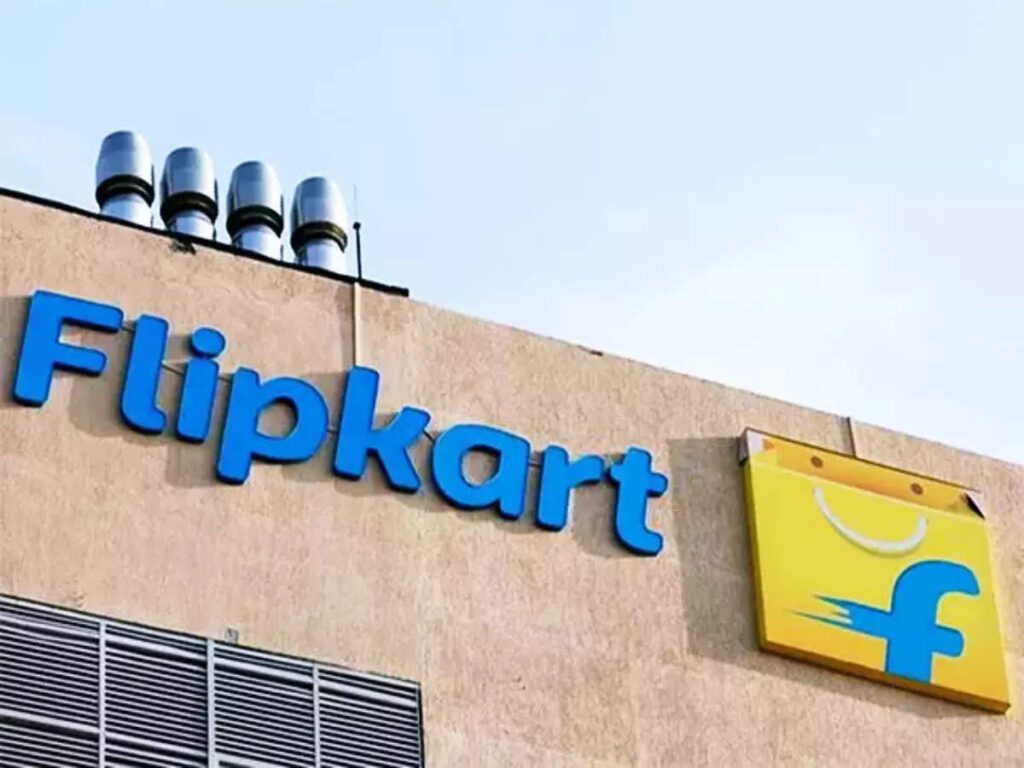
There are several compelling reasons to think about selling on Flipkart, including the following:
- Customer Base: With over 300 million registered customers, Flipkart is one of the leading e-commerce platforms in India. By selling on Flipkart, you can tap into this large customer base and reach a bigger audience.
- Simple to get started: Setting up a seller account on Flipkart is simple, and you may begin displaying your products within a few days. All you need is a product and a few documents to get started.
- Seller Support: Flipkart provides a variety of seller tools and services to assist you in effectively managing your business. This includes inventory management tools, seller support, and marketing and promotion services.
- Payment options: Flipkart accepts debit and credit cards, cash on delivery, and other methods of payment. This can make it easy for customers to buy and improve sales.
- Quality control: Flipkart has strong quality control measures in place to ensure that customers receive high-quality products. This can help you create trust with your customers, resulting in repeat business and great evaluations.
- Brand popularity: Flipkart is a well-known and renowned brand in India, which might assist to raise your credibility and sales.
- Transparent system: Flipkart provides equal opportunities for growth to all sellers who list their products on the portal which makes the system transparent.
How To Become A Seller On Flipkart?
Becoming a Flipkart seller is a breeze, but it comes with some initial groundwork and paperwork. Let’s dive into the step-by-step roadmap:
1. Sign Up and Kickstart
- Visit the Flipkart Seller Hub at seller.flipkart.com.
- Hit “Start Selling,” punch in your mobile number for a quick verification.
- Toss in your email, and pick your selling category (remember, all categories need GSTIN, except books, which just need PAN).
- Pop in your GSTIN or PAN, and click “Register & Continue.”
2. Shape Your Profile
- Unleash your business details, share contact info, and spill those bank account deets.
- Forge a robust password and validate your email.
- Toss in documents like PAN card, address proof, bank account specifics, and GST certificate if it’s in your toolkit.
3. Showcase Your Wares
- Navigate to the right product category and sub-category.
- Elevate your products with top-notch images and crisp descriptions.
- Slap on competitive prices and keep those stock levels ship-shape.
- Sprinkle in relevant keywords for better discoverability.
4. Order Juggling Act
- When an order knocks, process it with a snap and wrap it up securely.
- Take your pick: either ship it yourself or let Flipkart handle the logistics. Generate those labels.
- Swift dispatch is the name of the game; delays? Penalty awaits.
5. Cash In
- Flipkart showers payments 7 days post-dispatch (minus the inevitable fees).
- Cross your T’s and dot your I’s in the bank details section for a seamless cash flow.
Flipkart Seller Registration Step-by-Step Guide
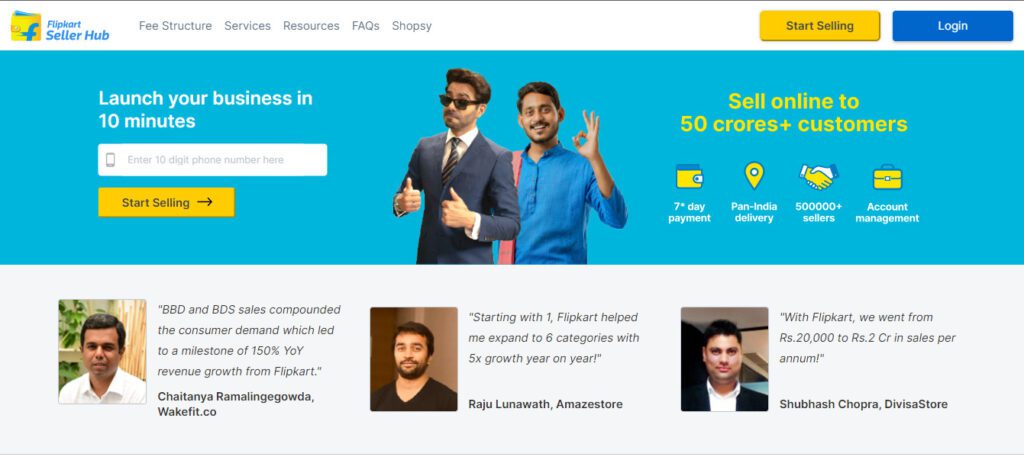
You have to have a seller account on Flipkart to start your online business. Follow these step by step guide to register your Flipkart seller account:
Step 1 – Enter Contact Details
To commence, initiate the process by furnishing your contact details. Offer your mobile number, a pivotal component for One-Time Password (OTP) verification, and input a valid email address to establish a robust connection with Flipkart’s Seller Hub.
Step 2 – Enter GSTIN or PAN
Proceeding to the GSTIN or PAN entry, a critical phase where the majority of product categories necessitate a GSTIN for differentiation within the marketplace. However, if your focus lies exclusively in the domain of book sales, a PAN card serves as a sufficient identifier. Here, you’re required to input either your company or individual GSTIN.
Step 3 – Create a Password
Following this, the creation of a robust password becomes paramount. It is advisable to select a password that amalgamates uppercase and lowercase letters, numbers, and symbols, thereby fortifying the security of your seller account.
Step 4 – Verify Your Email Address
The subsequent step involves verifying your email address. Execute this by clicking on the verification link dispatched to your registered email, a confirmation that solidifies your legitimacy within the Flipkart seller community.
Step 5 – Enter Your Signature
Moving forward, the upload of your signature assumes significance, introducing a personal touch that augments the authenticity of your seller profile. This involves providing a clear scan of your signature on a white paper background.
Step 6 – Enter Store and Pickup Details
Entering your store and pickup details surfaces as the next procedural checkpoint. Here, you define your store’s identity by supplying its name, address, and contact information. Additionally, you determine your preferred pickup method, whether it’s self-shipping or relying on Flipkart for fulfillment.
Step 7 – Enter Bank Details
Bank details submission follows suit, a pivotal step for the seamless processing of payments. It is imperative to ensure that the provided bank account details align precisely with the registered business name, mitigating any potential discrepancies.
Step 8 – Create a New Listing
Advancing in the journey, and creating a new listing for your products assumes centrality. This task encompasses selecting the appropriate product category, sub-category, and brand. Moreover, it involves uploading high-quality product images, crafting clear descriptions, setting competitive prices, and ensuring accurate stock levels to optimize your product listings for enhanced search visibility.
Details Required for Flipkart Vendor Registration
- Valid mobile number and email.
- GSTIN (except for books) or PAN card.
- Business proof (PAN card, Shop Act License).
- Bank account details.
Registration Requirements for Sole Proprietorship
- Individual’s PAN card with address proof.
- Canceled cheque or bank statement.
- Declaration of Sole Proprietorship.
Flipkart Seller Account Login
Accessing your Flipkart Seller Account is a straightforward process with these simple steps:
Step 1: Begin by visiting the official Flipkart seller page to sell online.
Step 2: Look for the Flipkart seller account login button, conveniently positioned next to the “Start Selling” button in the upper right corner of the website.
Step 3: Once you click on the login button, you’ll seamlessly enter your Flipkart seller dashboard. This intuitive dashboard becomes your command center, facilitating efficient management of product listings and real-time monitoring of available inventory.
Step 4: Prioritize the security and privacy of your online store by meticulously managing user access. Flipkart empowers you to add up to five users, each endowed with specific permissions. These roles, including admin, operations manager, catalogue manager, and ads manager, offer a tailored approach to controlling and delegating responsibilities effectively. This robust system ensures that your Flipkart selling experience is not only user-friendly but also secure and customizable to your operational needs.
How to Sell Products on Flipkart?
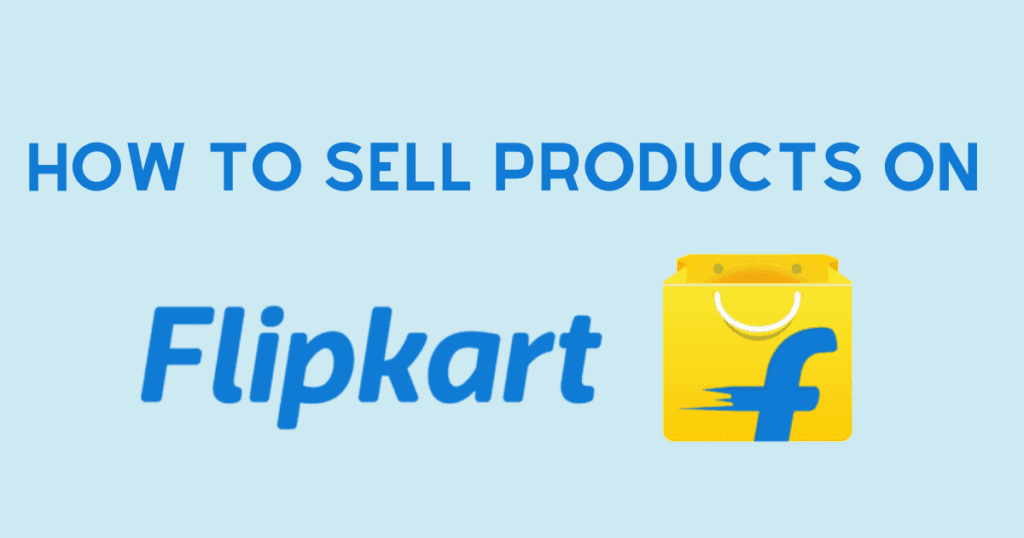
If you are wondering how to sell products on Flipkart with ease, Follow these steps:
1. Register as a Seller
Follow the straightforward registration process detailed in the previous section to become a Flipkart seller. Ensure all necessary documents and information are at your fingertips.
2. List Your Products
Access your seller account and initiate the product listing process. This step is crucial; craft accurate and compelling product descriptions, accompany them with high-quality images, and strategically set competitive prices to stand out in the marketplace.
3. Set Up Shipping Options
Tailor your shipping strategy according to your business needs. Decide on shipping costs and delivery timelines. You have the flexibility to opt for Flipkart’s logistics services or manage shipping independently. Make choices that align with your operational efficiency and customer expectations.
4. Keep Track of Inventory
Efficient inventory management is key to a successful seller journey. Regularly update your listings to reflect accurate stock levels. This not only prevents overselling but also contributes to maintaining your seller rating.
5. Take Orders
When a customer places an order, the Flipkart system promptly notifies you through your seller account. Stay vigilant and ready to fulfill incoming orders promptly.
6. Prepare and Dispatch Products
Carefully package your products, ensuring they are well-protected for transit. Ship orders within the stipulated timeframe to uphold customer satisfaction. Whether you opt for Flipkart’s logistics or manage shipping independently, reliability is paramount.
7. Get Paid
Upon successful delivery of the order and the customer’s satisfaction, Flipkart will release the payment to your bank account. Be mindful of commission costs deducted during this process.
8. Customer Service Excellence
Elevate the customer experience by offering exceptional service. Respond promptly to queries and concerns, ensuring a positive purchasing journey for your customers. Timely communication and problem resolution contribute significantly to building trust and customer loyalty.
How to Sell Products Online in India
To List Your Products follow these steps:
1. Flipkart Seller Central
Access your seller dashboard through “Flipkart Seller Hub” at seller.flipkart.com.
2. Choose Category
Select the most fitting category and sub-category for your products.
3. Product Information
- High-Quality Images: Present clear and appealing product images from different perspectives.
- Accurate Descriptions: Provide detailed descriptions, highlighting features, benefits, specifications, and materials.
- Keywords: Optimize your listing with relevant keywords for enhanced search visibility.
- Competitive Prices: Set prices competitively, considering market trends and profit margins.
- Accurate Stock Levels: Regularly update stock levels to prevent overselling.
4. Choose Fulfillment
- Flipkart Standard Delivery: Flipkart manages order placement, packaging, and delivery through third-party logistics partners, offering standard timelines and pan-India reach.
- Flipkart Assured Delivery: Similar to Standard Delivery, with faster lead times and potential for increased visibility and trust. Requires meeting specific performance benchmarks.
5. Manage Orders and Shipping
- Process Orders Promptly: Upon receiving an order, securely pack and process it within the specified timeframe.
- Generate Shipping Labels: Choose your preferred fulfillment method (self-shipped or Flipkart Fulfilled) and generate shipping labels within the portal.
- Dispatch Orders: Ensure timely dispatch to avoid penalties and maintain high customer satisfaction.
Additional Tips:
- Compliance: Familiarize yourself with Flipkart’s seller policies, return policies, and shipping guidelines.
- Customer Service: Offer excellent customer service to foster positive feedback and build trust.
- Performance Monitoring: Regularly monitor performance metrics (sales, feedback, reviews) and analyze feedback to enhance listings and sales.
- Premium Programs: Consider subscribing to Flipkart’s premium seller programs for added benefits and features.
Remember:
- You must be a resident of India and at least 18 years old to become a Flipkart seller.
- Certain product categories may require additional licenses or permits.
- Flipkart charges various fees for registration, listing, and fulfillment services. Stay informed and maximize your selling potential on this dynamic online platform.
Flipkart Seller Fee – Breakdown
Engaging in selling on Flipkart requires a clear understanding of the diverse fees associated with the platform. This awareness is crucial for calculating profit margins and strategizing your business effectively:
1. Fixed Fee:
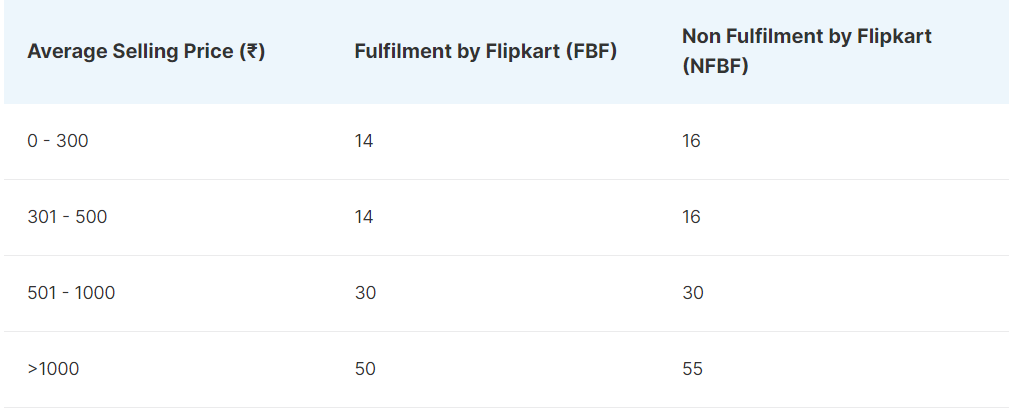
The Flipkart item fees vary based on the value of the ordered item. Use this table to calculate your fee.
- Charged per item for all successful orders (excluding returns or cancellations).
- Varies based on the order item value and specific product sub-category.
- No fixed fee is levied for customer or courier returns.
2. Commission Fee:
- A percentage of the order item value and shipping fee imposed by Flipkart for utilizing their platform.
- Ranges from 2.8% to 25%, contingent on the product sub-category.
3. Collection Fee:

- Calculated as a percentage of the total order value (including shipping) and is applied for payment processing.
- The percentage varies from 2% to 15% based on the seller’s tier and the chosen payment mode.
4. Shipping Fee:
- Determined by the weight, dimensions, and destination of the shipped item.
- Can be either borne by the seller (self-shipped) or by Flipkart (Flipkart Fulfilled).
- Flipkart extends subsidized shipping rates for sellers meeting specific criteria.
Flipkart Seller Commission
Understanding Flipkart’s commission charges is crucial for sellers aiming for financial transparency. Here’s a breakdown for clarity:
1. Fixed Fee:
- Determined per item based on the order value and sub-category.
- Replaces the previous Fixed Closing Fee.
2. Commission Fee:
- A percentage of the order value and shipping fee imposed by Flipkart for platform usage.
- Replaces the earlier Selling Commission.
3. Shipping Fee:
- Continues to be determined by factors like weight, dimensions, and the destination of the product.
4. Collection Fee:
- A percentage of the total order value covers payment processing.
- Replaces the erstwhile Service Tax.
Notes:
- Service Tax charge is discontinued and now integrated into the Goods and Services Tax (GST), included in the Collection Fee.
- For the latest and most accurate information on Flipkart’s commission charges, always refer to their official fee structure at Flipkart Fees and Commission.
How to Increase Sales Online on Flipkart
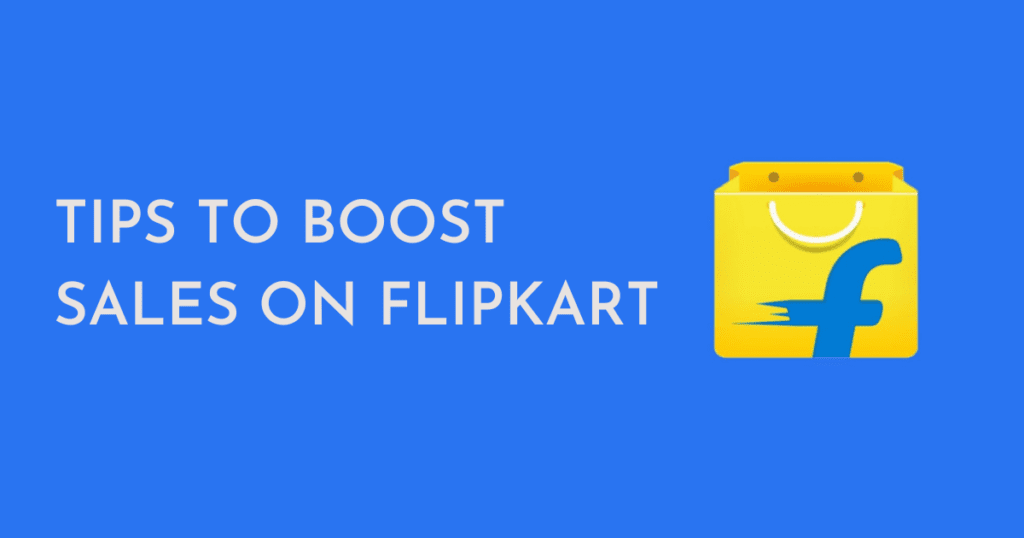
Since you now know how to sell products on Flipkart, you should consider some strategies for increasing your Flipkart sales. They are:
1. Improve your product listings: Make sure your product titles, descriptions, and photographs are accurate and of good quality. To increase the exposure of your products, use keywords that customers are likely to look for.
2. Provide competitive pricing: Do market research to ensure your prices are competitive with those on Flipkart for similar products. Try offering discounts or promotions to entice customers.
3. Offer exceptional client service: Respond quickly to customer enquiries and offer support as needed. Good customer feedback can boost your seller rating and bring in additional clients.
4. Make use of Flipkart’s marketing tools: Try leveraging Flipkart’s advertising solutions, such as Sponsored Items and Brand Advertising, to boost the visibility of your products.
5. Use Flipkart’s logistics services: Using Flipkart’s logistics services can assist you in reaching more customers and improving delivery times.
6. Provide free shipment: If you want to attract clients seeking a good deal, consider offering free shipping on your products.
7. Engage in Flipkart sales and promotions: Take advantage of Flipkart’s sales and promotions, such as Big Billion Days and Festive Season Sales, to attract more customers and increase sales.
8. Keep track of your performance metrics: Keep track of your performance data, such as your seller rating and customer feedback. Use this data to find areas for development and make changes to your sales plan.
Common Mistakes to Avoid While Selling Products on Flipkart
Now that you know how to sell products on Flipkart, here are some common mistakes most new sellers make while selling products online. If you want to know how to sell products on Flipkart successfully, you should avoid these mistakes:
1. Bad product listings: Make sure that your product listings are accurate and feature high-quality photographs and descriptions. Low sales and unfavorable customer evaluations might result from poor product listings.
Inaccurate inventory management: Monitor your inventory levels and change your listings as needed. Offering out-of-stock products might result in unfavorable customer comments and hurt your seller rating.
2. Ignoring customer input: Reply swiftly to customer feedback and address any issues or concerns. Ignoring consumer criticism might damage your reputation and lead to reduced sales.
3. Not providing competitive pricing: Do market research to ensure your prices are competitive with those on Flipkart for similar products. A lack of competitive pricing might result in poorer sales and consumer satisfaction.
4. Bad customer service: Respond quickly to customer inquiries and offer support as needed. Bad customer service can result in unfavorable customer reviews and fewer sales.
5. Failure to use Flipkart’s tools and services: Use Flipkart’s tools and services, including as advertising and shipping, to boost your sales and reach more customers.
6. Unable to monitor performance metrics: Keep track of your performance data, such as your seller rating and customer feedback. Use this data to find areas for development and make changes to your sales plan.
Flipkart’s seller and customer service
E-commerce is one of the best Low-cost Business Ideas With High Profits in India. Platforms like Flipkart offers excellent seller and customer care to guarantee that both sellers and customers have a great experience on the site. Flipkart provides seller support to assist with product listing, inventory management, and order fulfilment concerns.
Seller University is an online training programme designed to assist sellers in achieving success in the marketplace. Flipkart provides performance data, such as seller ratings and customer comments, to assist sellers in monitoring their performance and identifying areas for development. Flipkart also offers a safe payment and settlement system for merchants to get cash for their platform sales.
Hopefully, now you know how to sell products on Flipkart and earn profits. We wish you success in your business.
Conclusion: Want To Sell Products On Other Platforms
In conclusion, selling products on Flipkart can be a terrific method for businesses to expand their reach and grow sales in India. Flipkart provides a good experience for both merchants and customers with its extensive seller and customer care.
If you’re planning to broaden your online footprint, there’s a multitude of reputable platforms awaiting exploration. Diversifying your presence can significantly enhance your sales opportunities. Here’s a glimpse of noteworthy platforms worth considering:
- Blinkstore
- Amazon
- eBay
- Etsy
- Shopify
Before venturing onto any platform, meticulous research into specific requirements, fees, and policies is crucial.
Overall, Flipkart has established itself as a prominent e-commerce platform in India, providing a tremendous chance for businesses to expand and prosper. By now, you should know how to sell products on Flipkart and earn profits. You can also check out some of the Best Dropshipping Suppliers in India for shipping your products individually. Good luck!
FAQs
How can I become a Flipkart seller?
To become a Flipkart seller, go to the Flipkart Seller Dashboard and fill out the necessary information and documentation and get verified.
How much commission does Flipkart take?
In Flipkart, Commission fees vary by product category but typically range from 3% to 20%.
How can I improve the visibility of my product listings on Flipkart?
Provide accurate and complete product information, high-quality photos, and competitive pricing to optimise your product listings.
How can I increase my Flipkart sales?
You can Increase your Flipkart sales by offering competitive pricing, optimising your product listings, giving exceptional customer support, participating in specials and sales, and utilising Flipkart’s advertising and logistical services.
What kind of assistance does Flipkart offer to sellers?
Flipkart offers full seller support, including seller training, performance analytics, payment and settlement, and seller support for any concerns with product listings, inventory management, and order fulfilment.
How to sell products on Flipkart?
Easiest way to sell products on Flipkart is to register yourself as a seller, provide the necessary documentations and list your products on the portal.
How much Flipkart charge from sellers?
Flipkart’s commission fee varies based on the product category and seller tier, typically ranging from 3% to 20% of the order value and shipping fee. To find the precise commission rate for your specific product category, refer to Flipkart’s fees page: Flipkart Fees and Commission.
What charges do sellers incur on Flipkart?
Beyond the commission fee, sellers encounter several other charges:
Fixed Fee: A per-item charge based on the order value and sub-category.
Collection Fee: A percentage of the total order value for payment processing (2% to 15% based on seller tier and payment mode).
Shipping Fee: Determined by the weight, dimensions, and destination of the shipped item.
Optional Fees: Include product listing fee (for some categories), advertising fees, late dispatch fee, return processing fee, etc.
Is it possible to sell on Flipkart without a TIN?
You usually need a Tax Identification Number (TIN) to sell on Flipkart. Without it, you might only sell certain items, like books and unstitched materials.
Is selling on Flipkart profitable?
Profitability hinges on factors such as product margins, sales volume, order management efficiency, and competition. While Flipkart presents a substantial customer base and growth potential, it’s vital to meticulously calculate costs, encompassing fees, marketing, and logistics, before commencing your selling journey.
